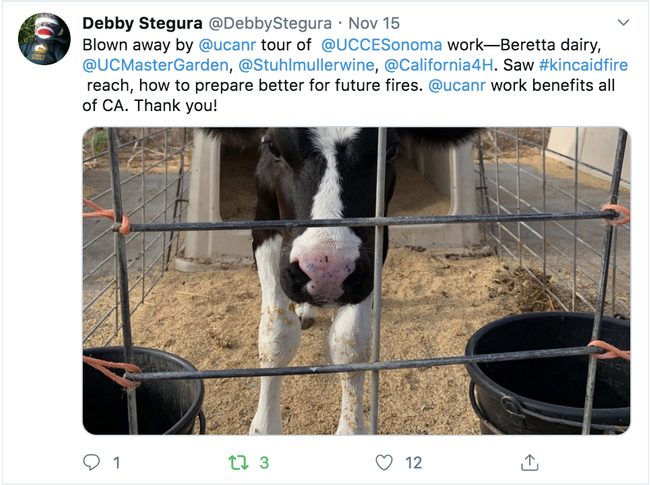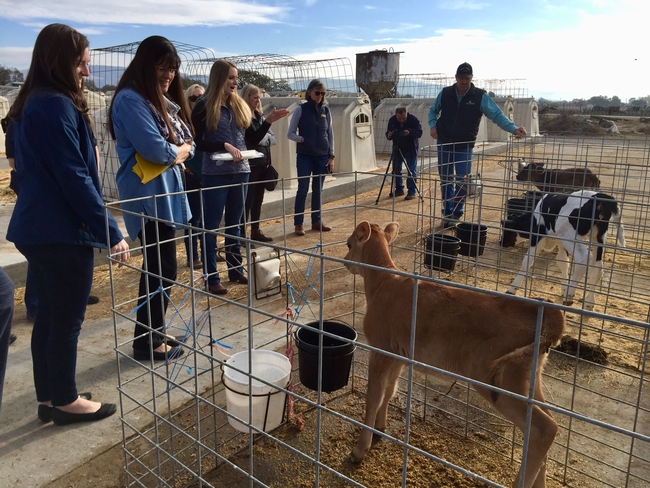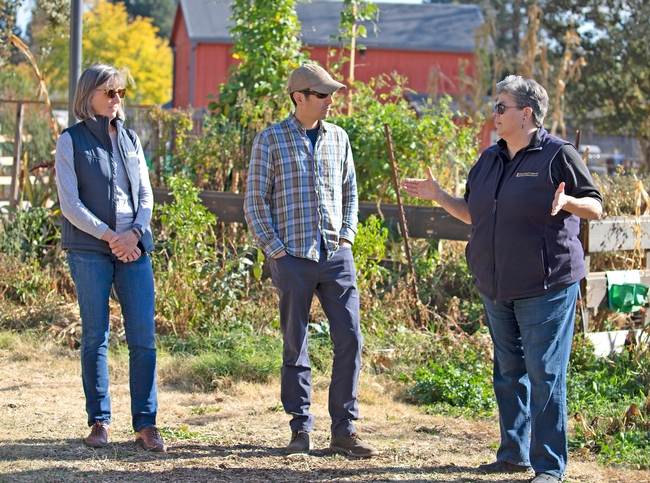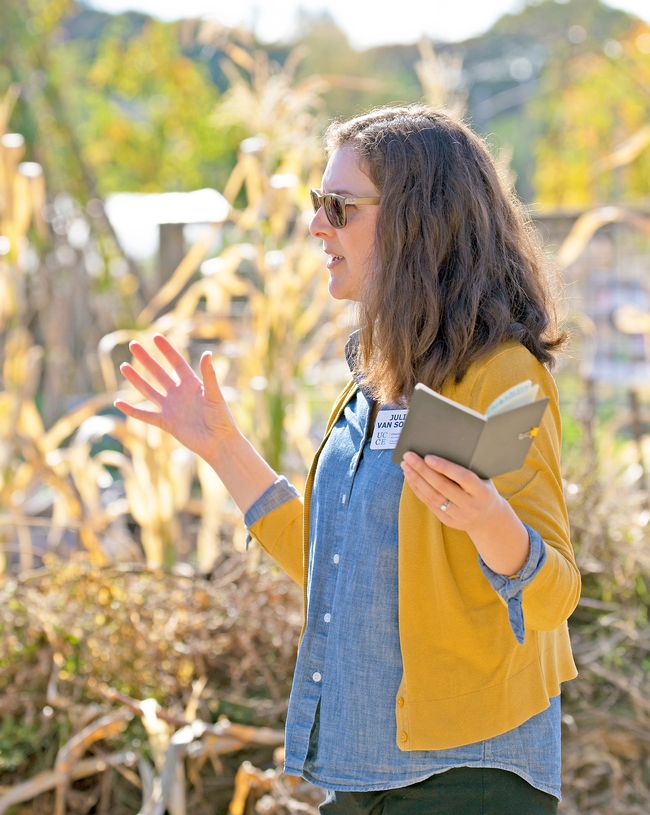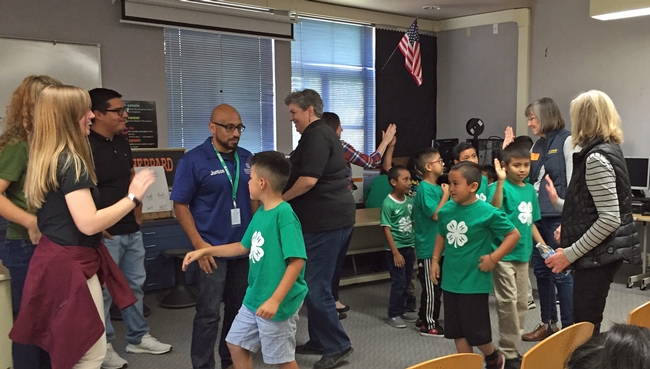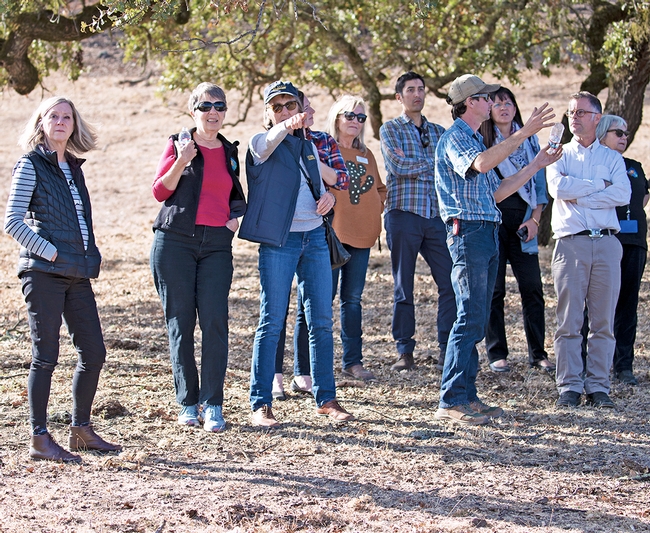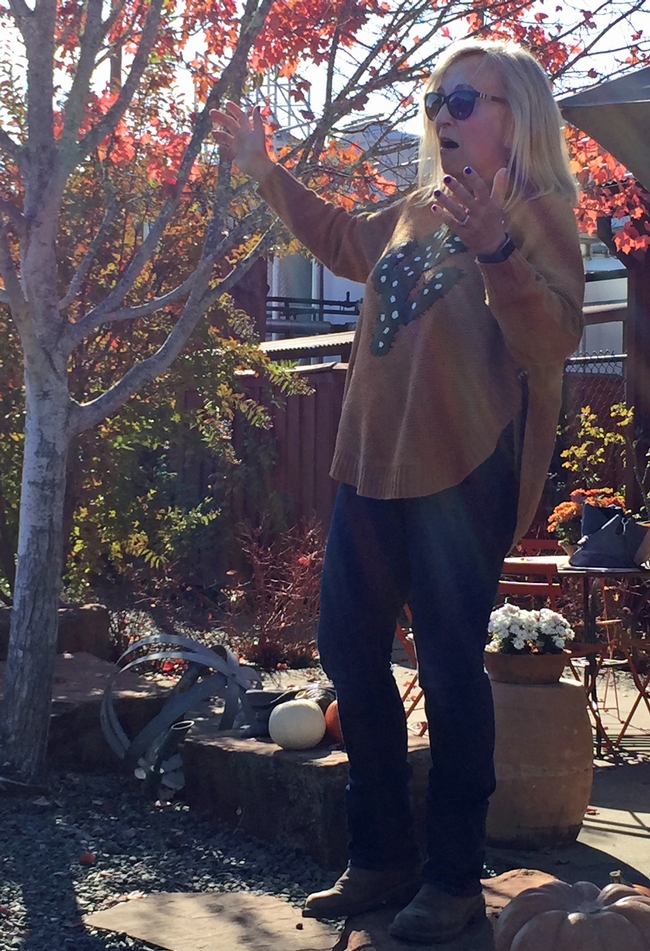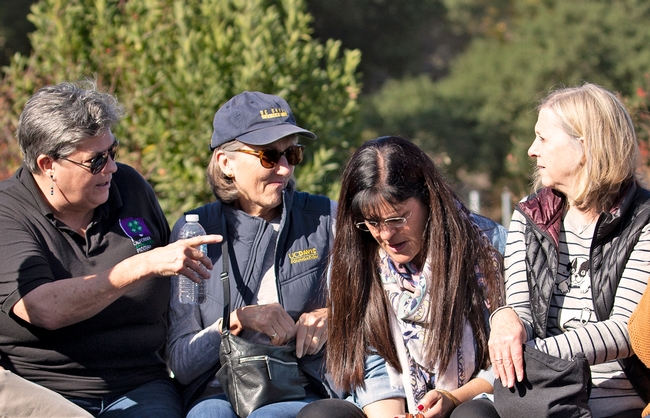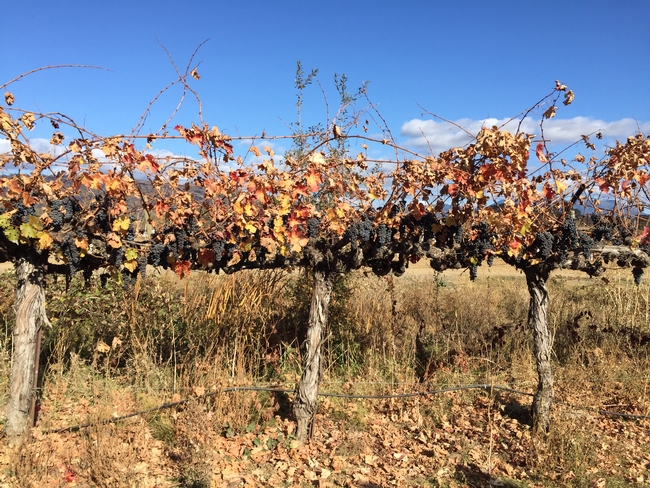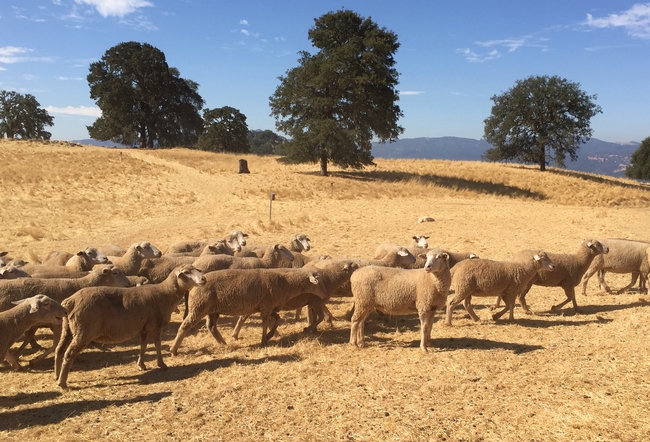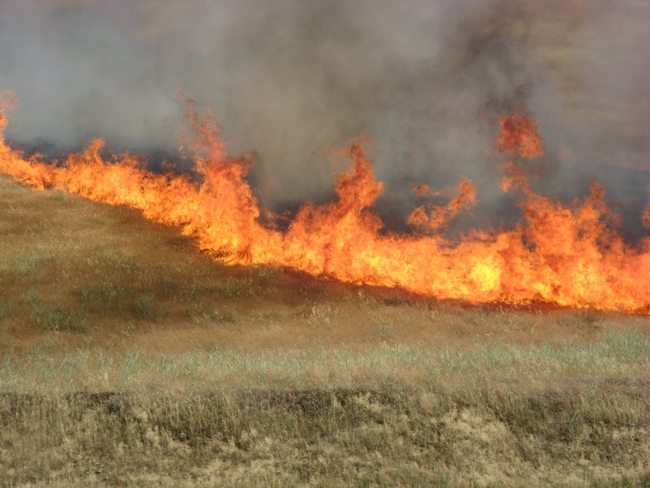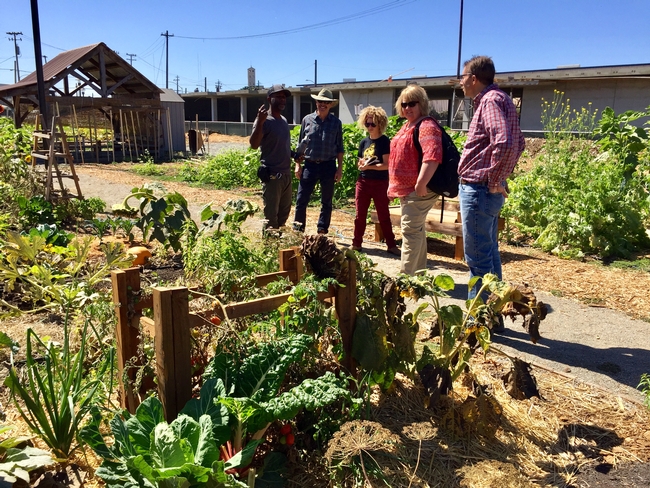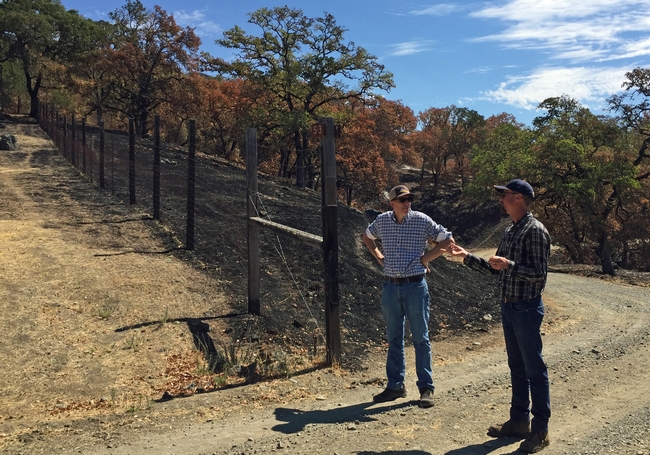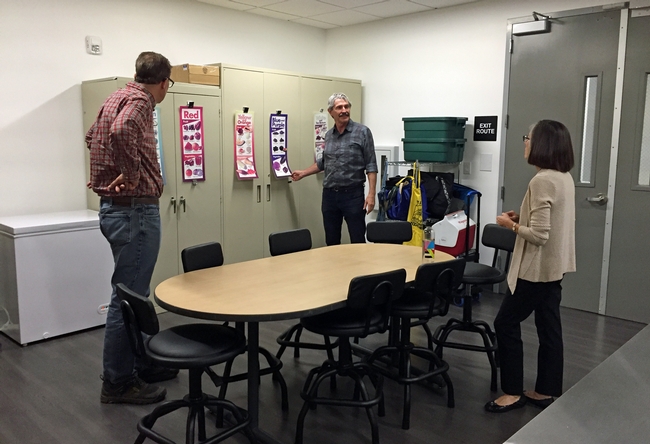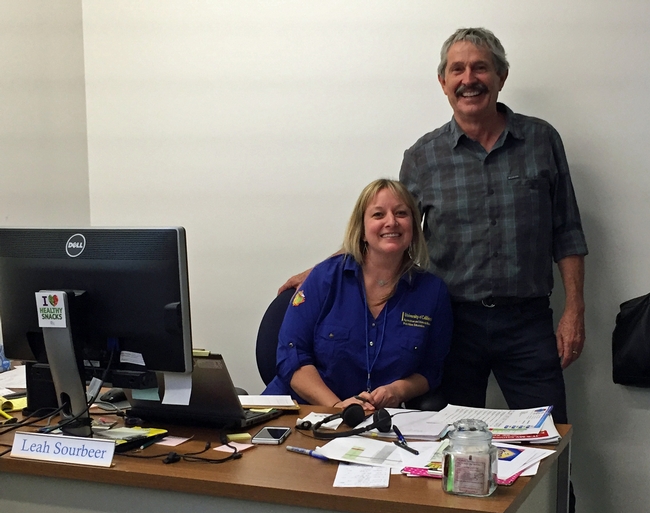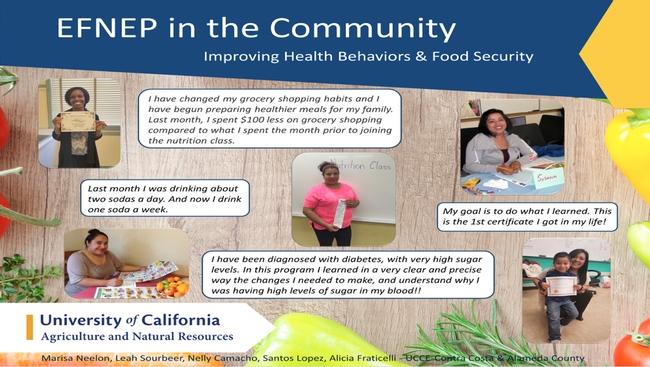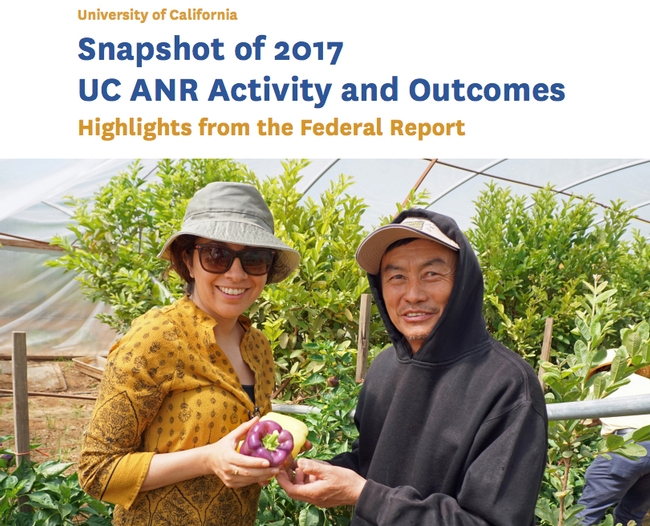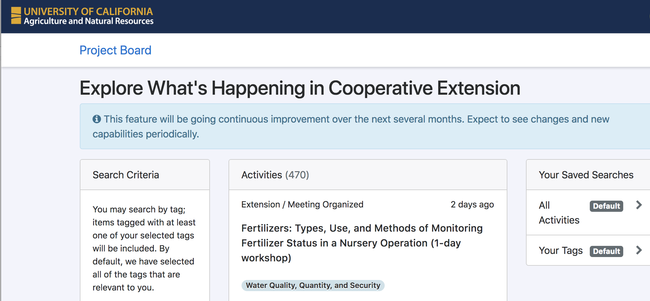Posts Tagged: Stephanie Larson
Regent Stegura 'blown away' by UCCE Sonoma work
Vice President Glenda Humiston introduced alumni regent-designate Debby Stegura to UC Cooperative Extension staff and their community partners and clientele in Sonoma County on Nov. 15.
After visiting Beretta Dairy, Bayer Farm Park and Gardens, Sheppard Elementary and Stuhlmuller Vineyards, Regent Stegura tweeted:
“Blown away by @ucanr tour of @UCCESonoma work—Beretta dairy, @UCMasterGarden, @Stuhlmullerwine, @California4H. Saw #kincaidfire reach, how to prepare better for future fires. @ucanr work benefits all of CA. Thank you!”
The retired business litigator and UC Davis alumna was joined on the tour by Anne Shaw, secretary and chief of staff to the regents, and Michael Bedard, UC state government relations legislative director.
Stephanie Larson, UCCE director for Sonoma County, led the tour, which first visited Beretta Dairy.
“It's so nice to have a dairy advisor,” Sonoma County dairy farmer Doug Beretta said, crediting Randi Black, UC Cooperative Extension dairy advisor, with providing the technical assistance he needed to apply for a grant to reduce methane emissions.
Black, who joined UC ANR in 2017, helped four local dairies obtain grants totaling $2.5 million and said the projects propose to reduce emissions by 9,327 metric tons of CO2 equivalent over the next 5 years, which is comparable to removing 2,028 passenger vehicles from the road for a year.
Beretta talked about the work he has done at the dairy, based on UC research, to improve water quality. David Lewis, UCCE director for Marin and Napa counties, noted that similar manure management and water-quality work is being implemented by UCCE clientele in his counties.
Discussing the hardships created by low milk prices in the dairy industry, Beretta said he appreciated UCCE's agricultural ombudsman Karen Giovannini guiding producers who want to sell value-added products through the permitting process.
From the dairy, Stegura and the group met with Mimi Enright, UC Master Gardener Program manager for Sonoma County, UC Master Gardener volunteers and Julia Van Soelen Kim, North Bay food systems advisor at Bayer Farm Park and Gardens.
Collaborating with Bayer Farm, the Master Gardeners have been expanding outreach to Spanish-speaking members of the community. In addition to all of the traditional Master Gardener outreach, the Master Gardeners in Sonoma County have been actively promoting firewise landscaping to help Sonoma County residents better prepare for wildfires. Using UC ANR materials is critical, Enright said, to assure people the recommendations are based on scientific research.
After the Kincade Fire, when growers and gardeners asked if produce grown outdoors was safe to eat, Enright said UCCE Sonoma County could tell them, based on local research, it was safe to eat if consumers removed outer leaves and washed the produce and that the health benefits of eating fresh produce outweigh any trace contamination.
UCCE has been leading a coalition of community partners and government organizations to educate the community on reducing food waste and increasing food recovery. When PG&E announces public safety power shutoffs, they promote composting food that can't be eaten so it doesn't end up in a landfill.
“This kind of service in communities is not as well-known about UC as the campuses,” Humiston commented to the regent.
Across the street from Bayer Farm, Diego Mariscal, 4-H program assistant, has been collaborating with Sheppard Elementary School. It is one of several schools in the county providing 4-H afterschool clubs and other 4-H programs designed to nurture the next generation of Latino leaders. Last spring, Mariscal worked with families to build a 4-H soccer league for elementary school children. Parents, college and high school students were trained by 4-H to teach children teamwork, soccer skills and healthy eating habits. More than 200 new underserved youth participated in 4-H programs in Sonoma County during the 2018-2019 year.
A few of the soccer players, proudly wearing their green 4-H soccer uniforms, told the group what they liked about 4-H. 4-H All Star Corrianna E., who participates in the 4-H teen program, shared her experience in 4-H and expressed gratitude to the program for helping her overcome her shyness to become a strong public speaker. Corrianna's mother, Naomi Edwards, also shared her experience as 4-H Council President for Sonoma County.
The tour's last stop was at Stuhlmuller Vineyards, where vineyard manager John Gorman told Stegura and the group that California's preeminent grape growing region relies on UCCE for sound advice to manage pests and emerging problems.
“You want to know what's a good cultural practice? Rhonda Smith has answers backed up by hard science,” Gorman said of the UCCE viticulture advisor.
Larson introduced new UC IPM advisor Cindy Kron, who succeeds recent retiree Lucia Varela. Kron is launching an IR-4 project to study pesticides for olives, which isn't a big enough market to interest private investment in research. She's also monitoring pears for brown marmorated stink bug because early detection is key to controlling the pest. Spotted lanternfly isn't in California yet, but grapes are among its favorite hosts so Kron is working with UC Master Gardener volunteers and other community members to watch for the exotic pest.
The Kincade Fire destroyed fences and scorched the rangeland at Stuhlmuller Vineyards, forcing Gorman to sell the cattle. He showed the group where the fire failed to advance at the fire break created by the lush vineyards. As a result of the Kincade Fire, Gorman wasn't able to sell his petite verdot, chardonnay and cabernet grapes to wineries. To prove to the insurance company that smoke damaged the crop, his crew picked 30 tons of grapes for testing.
During and after the devastating fires in the North Bay, Larson, who is also a UCCE livestock and range management advisor, assisted livestock owners to gain access to their burned properties; this ensured their animals got food and water. She also organized resource meetings for landowners affected by fires, helping them apply for funding from government agencies and insurance companies for animal, forage and facility losses.
Larson also said her new grazing database Match.Graze has been well-received by ranchers and landowners in Sonoma and Marin counties who want to use grazing to reduce fire fuels. Land managers and grazers can sign up at ucanr.edu/matchgraze to hire sheep, goats, cattle and horses to manage fire fuels.
The regent tours in Sonoma Country and Fresno County were coordinated by Anne Megaro, government and community relations director. She is planning future tours for regents at UC South Coast Research and Extension Center and other locations in the spring.
Livestock and poultry owners asked to take survey on fire impact
People raising cattle, sheep, goats, poultry, swine, horses, llamas, alpacas, aquaculture species or other production-oriented animals in California who have experienced at least one wildfire on their property within the last 10 years are being asked to participate in a Fire Impact and Risk Evaluation (FIRE) survey.
“We will aim to quantify the impact of wildfires in different livestock production systems,” said Beatriz Martinez Lopez, director of the Center for Animal Disease Modeling and Surveillance in the UC Davis School of Veterinary Medicine. “The idea is also to create a risk map showing areas more likely to experience wildfires with high economic impact in California.
“This economic and risk assessment, to the best of our knowledge, has not been done and we hope to identify potential actions that ranchers can take to reduce or mitigate their losses if their property is hit by wildfire.”
Martínez López, who is also an associate professor in the Department of Medicine & Epidemiology at UC Davis, is teaming up with UC Cooperative Extension livestock and natural resources advisors and wildfire specialists around the state to conduct the study.
The research team includes
- Matthew Shapero, UC Cooperative Extension advisor in Ventura County
- Rebecca Ozeran, UCCE advisor in Fresno and Madera counties
- Stephanie Larson, UCCE livestock range management advisor in Sonoma and Marin counties
- Sheila Barry, UCCE livestock and natural resourcesadvisor, in Santa Clara, San Mateo, San Francisco, Alameda and Contra Costa counties
- Josh Davy, UCCE livestock, range and natural resources advisor in Tehama, Colusa and Glenn counties
- Max Moritz, UCCE wildfire specialist, UC Santa Barbara
- Luke Macaulay, UCCE rangeland planning and policy specialist at UC Berkeley
- Lenya Quinn-Davidson, UCCE wildfire advisor in Humboldt, Siskiyou, Trinity and Mendocino
- counties
“The idea came up in a conference in San Diego, just when we had several ongoing wildfires and we were discussing how poorly are some areas prepared for this and the need for better emergency planning, coordination and response when not only people, but also large animals are involved,” Martínez López said. “We hope this study will provide the foundation to advance in this direction.”
“Right now, we have no good estimate of the real cost of wildfire to livestock producers in California,” said Rebecca Ozeran, UC Cooperative Extension livestock and natural resources advisor for Fresno and Madera counties. “Existing UCCE forage loss worksheets cannot account for the many other ways that wildfire affects livestock farms and ranches. As such, we need producers' input to help us calculate the range of immediate and long-term costs of wildfire.”
Stephanie Larson, UC Cooperative Extension livestock and range management advisor for Sonoma and Marin counties, agreed, saying, “The more producers who participate, the more accurate and useful our results will be.”
“We hope the survey results will be used by producers across the state to prepare for wildfire,” said Matthew Shapero, UC Cooperative Extension livestock and natural resources advisor for Ventura and Santa Barbara counties, “And by federal and private agencies to better allocate funds for postfire programs available to livestock producers.”
The survey is online at http://bit.ly/FIREsurvey. It takes 15 to 30 minutes, depending on the number of properties the participant has that have been affected by wildfire.
“Survey answers are completely confidential and the results will be released only as summaries in which no individual's answers can be identified,” said Martínez López. “This survey will provide critical information to create the foundation for future fire economic assessments and management decisions.”
The team would like your help in encouraging livestock producers who have experienced wildfire to participate in the FIRE survey.
RECs and county office staff update ANR leaders on current projects
To get acquainted with the people at each ANR location, Mark Lagrimini, vice provost of research and extension, has been visiting research and extension centers and UCCE county offices and touring the facilities.
“I'm impressed with how passionate and dedicated you are to helping people,” said Lagrimini to UCCE Contra Costa staff after listening to their project updates. He has been impressed with the work he has seen at all of his ANR visits.
On Sept. 6, Lagrimini visited Hopland Research and Extension Center, three weeks after the River Fire consumed about two-thirds of its property.
“While the River Fire damaged parts of the center, none of the main buildings, residences, livestock nor staff were hurt by the fire,” said John Bailey, Hopland REC interim director.
Scientists are invited to a site tour on Oct. 19 to learn more about research opportunities at Hopland REC.
“With Hopland REC's extensive pre-fire historical data, plus immediate post-fire, pre-rain observations that we are collecting, we have the foundation to support relevant and timely research on the effects of fire and mechanisms of recovery,” Bailey said.
AVP Wendy Powers and Mark Bell, vice provost of Strategic Initiatives and Statewide Programs, are joining Lagrimini for many of the visits to learn the latest about UCCE research and outreach and to answer questions from staff.
On Sept. 11, Rob Bennaton, UCCE director in Alameda and Contra Costa counties, introduced Powers, Lagrimini and Bell to UCCE staff in their Hayward offices, then took them to West Oakland to tour City Slicker Farms. UCCE Master Gardeners and 4-H members partner with City Slicker Farms, teaching people how to grow food at the site.
“Success to us is putting food where people need it and giving them the skills to grow food,” said Rodney Spencer, executive director of City Slicker Farms.
In Concord, Marisa Neelon, UCCE nutrition, family and consumer sciences advisor in Contra Costa County, gave Powers, Lagrimini and Bell a tour of the new office space, which includes space for Master Garden volunteers, a kitchen for nutrition educators to prepare food and a lab for farm and IPM advisors to store and analyze samples.
Staff from each unit delivered a presentation about their current projects for the ANR leaders, who were joined by Humberto Izquierdo, agricultural commissioner for Contra Costa County and Matthew Slattengren, assistant agricultural commissioner.
Charles Go, 4-H youth advisor, and Adan Osoria, EFNEP community nutrition educator, described how 4-H and EFNEP teamed up for 4-H2O, an after school project aimed at reducing consumption of sugar-sweetened beverages and increasing water consumption to improve community health and wellness. They launched 4-H2O at John Swett High School in Crockett. At the request of 4-H members, the local school board approved hydration stations and instructed the schools to provide water at meal times, Go said.
Andrew Sutherland, Bay Area urban IPM advisor, described his research on baiting for cockroaches, subterranean termites and yellowjackets and outreach to educate pest control professionals to practice IPM in schools and multi-unit housing.
“I appreciate the work Andrew does,” said Izquierdo, noting that there is a need for pest management education, especially among the county's urban and immigrant populations.
After seeing all of the presentations, Bell said, “The enthusiasm you bring to your job is inspiring.”
After the visit, Powers wrote in her ANR Adventures blog on Sept. 14: “The programs we've seen in Contra Costa and Alameda Counties this week as well as Santa Clara County a couple weeks back are good reminders of the benefits to all of UC ANR when we have strong, relevant programs in urban areas. These programs not only help the clientele, directly, but help increase the visibility of UC ANR and all of its programs across both urban and ag areas.”
On Sept. 26, Powers, Lagrimini and Bell visited UCCE Riverside, then UCCE San Bernardino the following day.
“We spent yesterday in Riverside meeting with the teams from both UCCE Riverside and UCCE San Bernardino,” Powers wrote in ANR Adventures on Sept. 27. “It was very informative, particularly seeing the fresh ideas that are coming from some of the new staff. We were able to hear about the tremendous success that both counties are having truly working as a team across program areas and layering their efforts for increased program success and support.”
Federal Report Snapshot highlights ANR accomplishments
Each spring, the UC ANR Office of Program Planning and Evaluation (PPE) compiles and submits a report to our federal funding partner, USDA's National Institute of Food and Agriculture (NIFA). In August, NIFA approved UC ANR's 2017 report.
A snapshot of the 2017 UC ANR Federal Report is available at the following link: https://ucanr.edu/sites/anrstaff/Divisionwide_Planning. The snapshot highlights several dozen examples of research and extension occurring in each Strategic Initiative and in the field of sustainable energy. The Federal Report Snapshot can be shared with stakeholders and potential donors to help them better understand the breadth of projects and range of impacts that occur throughout ANR in a given year.
The full report that was submitted to NIFA captures the annual activities, outputs, and outcomes that occur throughout ANR as a result of NIFA funding on campuses, in counties and at the research and extension centers.
Information for the report comes from submissions entered in REEport, DANRIS-X (now replaced by Project Board for FY 2018 and on), and UC Delivers. Content experts identify the most significant research highlights and write the program area narrative summaries. This year we want to thank Chris Greer, Cheryl Wilen, Keith Nathaniel, John Harper, Doug Parker and Jeff Dahlberg. Because the report is thorough and lengthy, PPE has created this condensed snapshot, which is drafted with input from Communications Services.
Both the snapshot and full report are available at https://ucanr.edu/sites/anrstaff/Divisionwide_Planning.
Project Board integrates reporting and may facilitate collaboration
Project Board is a new online system that integrates ANR academic program review, civil rights compliance, and accountability reporting requirements. It also has search features that may facilitate collaboration and support advocacy efforts. Project Board launched on May 3, 2018, for academics who have ANR merit + promotion, and on July 31, 2018, for CE specialists whose merit + promotion packages are processed by a campus.
Project Board will be searchable by keyword by all ANR staff and academics to find projects. Only CE academics are required to enter information into the system. New features, bug fixes and help text are being continuously rolled out. Project Board works best on Firefox and Chrome web browsers.
Goodbye DANRIS-X!
Reporting for the federal fiscal year that began Oct. 1, 2017, and ends Sept. 30, 2018, is required in Project Board for all Cooperative Extension academics. Training information and technical assistance Zoom hours can be found on this webpage. DANRIS-X is closed for data entry but will remain open for retrievals and reports.
For more information:
- Visit Project Board Help: http://ucanr.edu/sites/ProjectBoardHelp/
- Academic Human Resources questions, contact Kim Ingram at kcingram@ucanr.edu
- Civil Rights Compliance/Affirmative Action questions, contact David White at dewhite@ucanr.edu
- General Project Board and Program Planning and Evaluation questions, contact Kit Alviz at kit.alviz@ucop.edu or Chris Hanson at Christopher.hanson@ucop.edu

